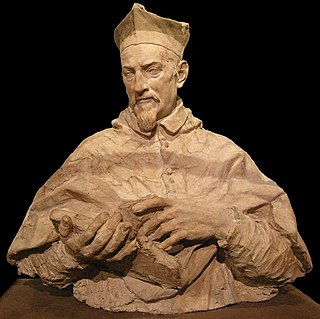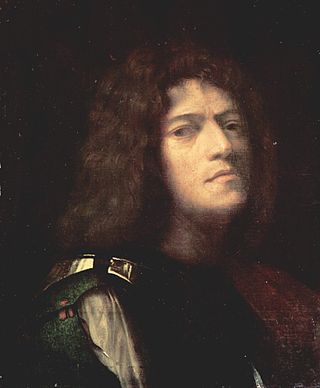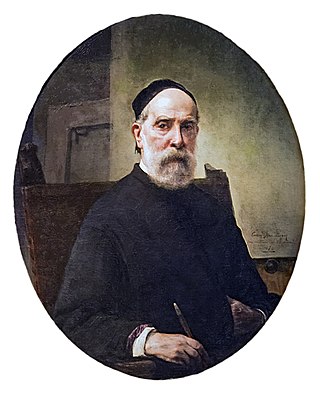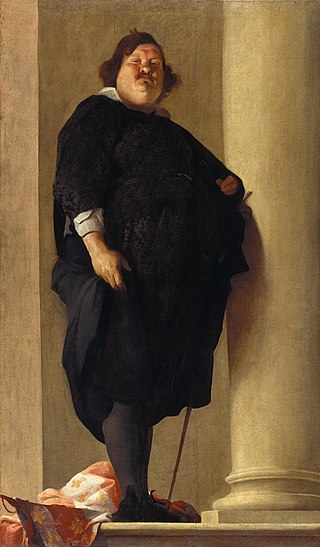
Portrait of a Gentleman (or sometimes The Tuscan General Alessandro dal Borro) is a c. 1645 oil-on-canvas painting usually attributed to the French Baroque artist Charles Mellin. It is in the collection of the Staatliche Museen, in Berlin.

Portrait of a Gentleman (or sometimes The Tuscan General Alessandro dal Borro) is a c. 1645 oil-on-canvas painting usually attributed to the French Baroque artist Charles Mellin. It is in the collection of the Staatliche Museen, in Berlin.
It is believed, but not established for certain, that it was commissioned by Alessandro dal Borro (1600–56), a Tuscan general, who fought with Mattias de' Medici in the Castro war against Pope Urban VII. Proud of his career and character, presumably dal Borro asked that the painter to do his likeness not shy away from depicting his stout build. [1] As such, the work is highly regarded for its amusing geniality. It is noted for being frank and striking, and as one of the earliest honest depictions of obesity. [2]
The portrait shows the man in full profile, standing next to a stone pillar, looking to his right, with a banner at his feet, bearing a coat of arms thought to be of Barberini family. He has thick red hair, a double chin and round, pudgy cheeks. [3]
It has been attributed to a number of artists over the centuries, including Velázquez, Bernini and Andrea Sacchi. [4] Today it is generally thought to be the work of Mellin, although there is no definitive evidence.

Alessandro Algardi was an Italian high-Baroque sculptor active almost exclusively in Rome, where for the latter decades of his life, he was, along with Francesco Borromini and Pietro da Cortona, one of the major rivals of Gian Lorenzo Bernini. He is now most admired for his portrait busts that have great vivacity and dignity.

Diego Rodríguez de Silva y Velázquez, Knight of the Order of Santiago was a Spanish painter, the leading artist in the court of King Philip IV of Spain and Portugal, and of the Spanish Golden Age.

Giorgione was an Italian painter of the Venetian school during the High Renaissance, who died in his thirties. He is known for the elusive poetic quality of his work, though only about six surviving paintings are firmly attributed to him. The uncertainty surrounding the identity and meaning of his work has made Giorgione one of the most mysterious figures in European art.

Paolo Caliari, known as Paolo Veronese, was an Italian Renaissance painter based in Venice, known for extremely large history paintings of religion and mythology, such as The Wedding at Cana (1563) and The Feast in the House of Levi (1573). Included with Titian, a generation older, and Tintoretto, a decade senior, Veronese is one of the "great trio that dominated Venetian painting of the cinquecento" and the Late Renaissance in the 16th century. Known as a supreme colorist, and after an early period with Mannerism, Paolo Veronese developed a naturalist style of painting, influenced by Titian.

Giorgio Giulio Clovio or Juraj Julije Klović was an illuminator, miniaturist, and painter born in the Kingdom of Croatia, who was mostly active in Renaissance Italy. He is considered the greatest illuminator of the Italian High Renaissance, and arguably the last very notable artist in the long tradition of the illuminated manuscript, before some modern revivals.

JeanFouquet was a French painter and miniaturist. A master of panel painting and manuscript illumination, and the apparent inventor of the portrait miniature, he is considered one of the most important painters from the period between the late Gothic and early Renaissance. He was the first French artist to travel to Italy and experience first-hand the early Italian Renaissance.

Simon Vouet was a French painter who studied and rose to prominence in Italy before being summoned by Louis XIII to serve as Premier peintre du Roi in France. He and his studio of artists created religious and mythological paintings, portraits, frescoes, tapestries, and massive decorative schemes for the king and for wealthy patrons, including Richelieu. During this time, "Vouet was indisputably the leading artist in Paris," and was immensely influential in introducing the Italian Baroque style of painting to France. He was also "without doubt one of the outstanding seventeenth-century draughtsmen, equal to Annibale Carracci and Lanfranco."

Francesco Hayez was an Italian painter. He is considered one of the leading artists of Romanticism in mid-19th-century Milan, and is renowned for his grand historical paintings, political allegories, and portraits.

Petrus Christus was an Early Netherlandish painter active in Bruges from 1444, where, along with Hans Memling, he became the leading painter after the death of Jan van Eyck. He was influenced by van Eyck and Rogier van der Weyden and is noted for his innovations with linear perspective and a meticulous technique which seems derived from miniatures and manuscript illumination. Today, some 30 works are confidently attributed to him. The best known include the Portrait of a Carthusian (1446) and Portrait of a Young Girl ; both are highly innovative in the presentation of the figure against detailed, rather than flat, backgrounds.

The Portrait of a Musician is an unfinished painting widely attributed to the Italian Renaissance artist Leonardo da Vinci, dated to c. 1483–1487. Produced while Leonardo was in Milan, the work is painted in oils, and perhaps tempera, on a small panel of walnut wood. It is his only known male portrait painting, and the identity of its sitter has been closely debated among scholars.

Pope Paul III and His Grandsons is a painting in oil on canvas by Titian, housed in the Museo di Capodimonte, Naples. It was commissioned by the Farnese family and painted during Titian's visit to Rome between autumn 1545 and June 1546. It depicts the scabrous relationship between Pope Paul III and his grandsons, Ottavio and Alessandro Farnese. Ottavio is shown in the act of kneeling, to his left; Alessandro, wearing a cardinal's dress, stands behind him to his right. The painting explores the effects of ageing and the manoeuvring behind succession; Paul was at the time in his late seventies and ruling in an uncertain political climate as Charles V, Holy Roman Emperor came into ascendancy.

The Melun Diptych is a two-panel oil painting by the French court painter Jean Fouquet created around 1452. The name of this diptych came from its original home in the Collegiate Church of Notre-Dame in Melun. The left panel depicts Étienne Chevalier with his patron saint St. Stephen and the right panel depicts the Virgin and Christ child surrounded by cherubim. Each wooden panel measures about 93 by 85 centimeters and the two would have been hinged together at the center.

Charles IV in his Hunting Clothes is an oil on canvas painting of 1799 by the Spanish artist Francisco Goya, the second of his two portraits of King Charles IV of Spain.

Abraham de Vries was a Dutch painter who was one of the leading portraitists of his age. As he led a peripatetic lifestyle and worked in France, Antwerp and the Dutch Republic his stylistic qualities are difficult to pin down.

Charles Mellin was a French painter of the Baroque era. He was from Nancy, Lorraine, but spent his artistic career in Italy, where he was nicknamed Carlo Lorenese.

Marchese Alessandro dal Borro was a Tuscan nobleman and general. He became a Field Marshal of the Holy Roman Empire. He was well known for his obesity.

Profile Portrait of a Young Lady is a 1465 half-length portrait, made with oil-based paint and tempera on a poplar panel, usually attributed to Antonio del Pollaiuolo, although the owning museum, the Gemäldegalerie in Berlin, now describes this work as by his brother Piero del Pollaiuolo, and as one of its most famous paintings, and as one of the most famous portraits of women from the early Italian Renaissance.

Portrait of a Man is a c. 1478 painting by the Italian Renaissance painter Domenico Ghirlandaio (1449–1494) executed in tempera on wood.

The Portrait of Prince Alessandro Farnese is a painting by the 16th-century Italian artist Sofonisba Anguissola. It depicts the prince, later the Duke of Parma and Piacenza, as 15-year old boy, dressed in refined courtly clothing. Prince Alessandro was the son of Ottavio Farnese, Duke of Parma, and the grandson of King Charles V of Spain. The portrait was painted in c. 1560 and now hangs in the National Gallery of Ireland.

Portrait of Cardinal Alessandro Farnese is a c. 1545 – 46 oil on canvas three-quarter-length portrait of Alessandro Farnese the Younger (1520-1589) by Titian, now in the Museo nazionale di Capodimonte in Naples.